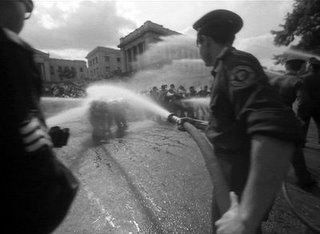The film was made in 1964 as a sort of valentine to the Cuban people, courtesy of Soviet filmmaker Mikhail Kalatozov, and although Communism isn’t directly mentioned in the story, its shadows hang unmistakably over the proceedings. The films "Western" characters are without exception portrayed as vacuous, sex-starved, or fascist.
"I Am Cuba" tells its story through four short vignettes, which are unrelated to each other. A shy Cuban prostitute loses the man who loves her as a result of a dalliance with a foreigner. A poor sugar cane farmer learns he will lose his land and home. A group of idealistic students clash with police and a simple farmer has a political awakening after a meeting with a young Fidel Castro.
The first features the shot that IAC is most renowned for. The camera starts on the roof of a luxury hotel, goes over the balcony and down the side of the building where it picks up on a young woman and follows her into the pool, ending up under the surface of the water – All in one unbroken shot. The film then moves to concentrate on the fruit seller Rene and his fiancée Maria. He talks of all the things he will do for her once they are married. The scene then shifts to a nightclub and focuses on a small group of foreigners. A blond, obviously American businessman stands out for his almost comical vulgarity. Surveying the prostitutes at the bar, he announces "I’ll have THAT tasty morsel!" This world is also a part of life for Maria, or Betty, as she is also known. Going home with one of the capitalists (who has the audacity to try to buy her crucifix!), she is discovered by Rene in a scene of sublime sadness.
 The second story revolves around Pedro, an elderly sugar cane farmer. Pedro works his land with his son and daughter, and his story is told in an astonishing dream sequence which lasts only a few seconds, but which speaks volumes. One day he is visited by the owner of his land who announces that it has been sold to a large fruit company, and he will have to move out. Pedro goes back to work and Kalatozov depicts him cutting cane in a frenzy of machete strikes and metallic ringing. Finally, a defeated Pedro sends his children to town and torches his crop and farm.
The second story revolves around Pedro, an elderly sugar cane farmer. Pedro works his land with his son and daughter, and his story is told in an astonishing dream sequence which lasts only a few seconds, but which speaks volumes. One day he is visited by the owner of his land who announces that it has been sold to a large fruit company, and he will have to move out. Pedro goes back to work and Kalatozov depicts him cutting cane in a frenzy of machete strikes and metallic ringing. Finally, a defeated Pedro sends his children to town and torches his crop and farm.
 Story Three is in many ways the most powerful of all, as student activist Enrique backs out of an attempt to assassinate a murderous cop, and promptly sees the same cop kill one of his colleagues. Police with fire hoses then interrupt a huge student rally, and Enrique comes face to face with the corrupt cop once again. This sequence achieves creates incredible energy as the crowd is whipped by hose spray and smoke. This segment concludes with a sequence where the camera follows a funeral procession, the leaves it to climb the side of a building, where it pans through a room of men rolling cigars, then goes over the balcony and seems to glide in midair over the procession again. It’s truly a virtuoso bit of cinematography.
Story Three is in many ways the most powerful of all, as student activist Enrique backs out of an attempt to assassinate a murderous cop, and promptly sees the same cop kill one of his colleagues. Police with fire hoses then interrupt a huge student rally, and Enrique comes face to face with the corrupt cop once again. This sequence achieves creates incredible energy as the crowd is whipped by hose spray and smoke. This segment concludes with a sequence where the camera follows a funeral procession, the leaves it to climb the side of a building, where it pans through a room of men rolling cigars, then goes over the balcony and seems to glide in midair over the procession again. It’s truly a virtuoso bit of cinematography.
Finally, in the final sequence, the quiet farmer Mariano finds Fidel Castro at his doorstep. After feeding him, the pacifist farmer sends him away, then has his home destroyed by an airstrike. Mariano announces to his wife that "I have to go and fight now", eventually ends up meeting you-know-who again. The film ends with a happy band of rebels emerging from the mountains, the revolution having been won.
"I Am Cuba" is above all else a product of its time. It was made on the heels of the Cuban Missile Crisis and as such, wears its anti-capitalist beliefs without apology. If the passing of time has revealed those beliefs to be naive, so be it. What remains is the film itself - Beautiful, exciting, provocative and endlessly innovative.
No comments:
Post a Comment